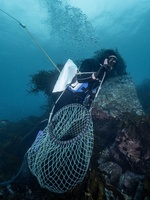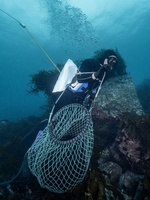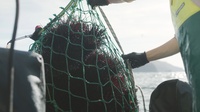Can we eat our way through an exploding sea urchin problem?
redmap-admin.
Written by John Keane and Scott Ling, the Conversation article looks into the devastating impact of unchecked sea urchin populations and highlights the urgency of intervention. They delve into existing research on control methods, emphasizing the limitations of lobster predation and the high costs of culling. The spotlight shifts to a promising alternative—commercial fishing—a scalable, long-term solution that hinges on the economic value of sea urchin roe, known as 'uni.'
Read the Conversation article
Longspined sea urchins are native to temperate waters around New South Wales. But as oceans heat up, their range has expanded more than 650km, through eastern Victoria and south to Tasmania. Their numbers are exploding in the process, clear-felling kelp forests and leaving “urchin barrens” behind.
The species (Centrostephanus rodgersii) is now the single largest and most urgent threat to kelp forests along the southeastern coast of Australia’s Great Southern Reef.
However, there's hope on the horizon.
The recently released Senate's Inquiry into Climate-Related Marine Invasive Species sheds light on a potential game-changer—a national Business Plan for collaborative urchin management. This plan, backed by two decades of scientific research, aims to protect and restore our coastal ecosystems.
Harvesting sea urchins for their roe, known as 'uni,' offers an affordable, scalable, and long-term approach. While challenges in processing and market access exist, success stories from Tasmania, where government investment kick-started an urchin industry, showcase the potential.
Tasmania's success with fishery-led control of overabundant sea urchins highlights a promising strategy. To maximize its impact, we can explore value-added opportunities, like expanding international markets, developing new uses for low-grade urchin roe and selling waste products. By making these efforts more profitable, divers could cover larger areas to manage urchin stocks effectively.
Guiding fishery efforts through subsidies in high-priority zones could enhance urchin control, benefiting states like Victoria facing similar challenges.
Achieving national, widespread urchin control will require challenging coordination. We need to:
- support dive fisheries to become the heavy lifter of urchin control
- add extra urchin control measures on high-value reefs
- begin restoring degraded barrens to a mosaic of urchin fisheries or kelp forests
- boost populations of urchin predators on healthy reefs, to increase resilience in the first place.
As we face the challenges of climate change and species redistribution, the Sea Urchin control program presents a global exemplar of climate-ready-australia. management of overabundant and range extending species, boosting rural economies and social wellbeing.
It's time to invest in a sustainable future for our oceans.
Read the Conversation article















